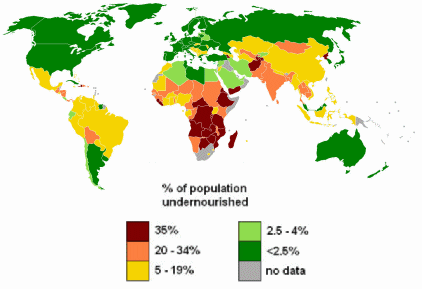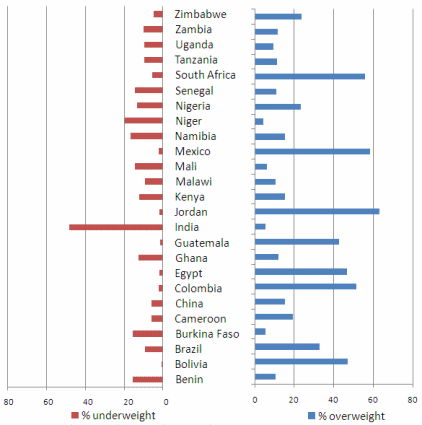By: Priya Shetty
Send to a friend
The details you provide on this page will not be used to send unsolicited email, and will not be sold to a 3rd party. See privacy policy.
A healthy diet is more than just calories. Priya Shetty gets the figures on the cost of poor nutrition — and the scale of the challenge.
Hunger: it’s an emotive term for undernutrition. It conjures images of famine and starvation in the developing world.
Technically, undernutrition is the outcome of insufficient food and repeated infectious diseases. It includes being severely underweight or dangerously thin (wasted), too short (stunted), and deficient in vitamins and minerals.
But the world’s food problems are far more complex and widespread than just undernutrition.
Certainly, some people have no food at all and every year approximately 1.5 million children die from wasting caused by severe undernutrition. But most people in poor countries never have to grapple with total starvation — for them, malnutrition caused by an imbalanced or inadequate diet is more likely.
Many rely too much on high-calorie staples, like maize or rice. Good nutrition is not just about consuming enough calories — people need protein and micronutrients they can only get through a balanced diet. When people do not, or cannot, eat a wide range of food, they become malnourished. They can survive, but cannot flourish.
Developing nations already prioritise food security, i.e. ensuring access to food. But it is increasingly clear that simply providing food is not enough. To protect vulnerable populations, governments must also ensure nutrition security.
To do this, they will need interventions that work. These must treat and prevent malnutrition in the short-term and address its underlying causes including poverty, low agricultural output, limited education, and poor healthcare and hygiene in the long-term.
The burden of malnutrition
Back in 2000, the WHO estimated malnutrition affected one in three worldwide. [1] In 2009, the Food and Agriculture Organization (FAO) estimated over a billion people suffer more serious undernutrition. [2]
This staggering statistic is partly the result of a slow but steady rise in the number of malnourished people over the past decade. Economic shocks are partly to blame. The 2006–2008 food and fuel crises priced millions of people out of access to basic staples. And last year’s financial crisis is estimated to have added 100 million to the number of malnourished people in the world. [2]
The developing world bears almost all of the burden, with South Asia and Sub-Saharan Africa the worst affected (see Figure 1).

Figure 1: Percentage of population that are undernourished (credit: FAO) [3]
The impacts of malnutrition can be severe (see Box 1). Even the lack of micronutrients that are only needed in miniscule amounts can be a killer, because without them the body cannot produce enzymes and hormones crucial for growth and development.
Box 1: Nutrition number crunch
Global burden
- 1.02 billion people suffer from undernutrition — a serious form of malnutrition.
- 99 per cent of undernourished people live in developing countries.
- 642 million people in Asia and the Pacific are undernourished.
- More than 60 per cent of chronically undernourished people are women.
Childhood malnutrition
- 6 million child deaths every year are linked to malnutrition.
- 1.5 million children die every year because they waste away from undernutrition.
- 178 million children become physically stunted, partly because of not having enough food or vitamins.
- 146 million children under five are underweight.
- More than 50 per cent of those underweight under-fives live in South Asia.
- 20 per cent of deaths in under-fives could be prevented by adhering to breastfeeding guidelines.
Micronutrient deficiencies
- More than 500,000 child deaths every year are linked to lack of vitamin A.
- More than 20 per cent of children under five in developing countries suffer from iron deficiency-related anaemia.
- 40–60 per cent of children in developing countries have impaired mental development due to iron deficiency.
- 2 billion people worldwide are iodine-deficient.
- 176,00 people die from diarrhoea linked to zinc deficiency each year.
- 406,000 people die from pneumonia linked to zinc deficiency each year.
Economic costs
- US$20–30 billion is what undernutrition is estimated to cost economic development each year.
- 12 per cent reduction in lifetime earnings in Zimbabwe is attributable to school years lost to malnutrition.
Overnutrition
- up to 20 per cent of children under five are overweight in some developing countries.
Adapted from statistics published by the WHO and the World Food Programme.
Nutrition and disease
Increasingly, scientists are realising that nutrition interacts with treatments for most diseases — whether infectious or chronic — and that controlling these diseases requires better nutrition.
Malnutrition and infection act together in a vicious, and often deadly, cycle. Malnutrition weakens the immune system, increasing susceptibility to infection. Infection, in turn, runs down nutrient and energy stores, impairing treatment and exacerbating the damage caused by infectious disease (see Box 2).
Box 2: HIV and malnutrition
Medical treatment for HIV may have advanced rapidly over the past few decades but a key ingredient for treating the disease — good nutrition — is often ignored.
Undernourished people have compromised immune systems, making them more vulnerable to HIV infection. HIV infection, in turn, makes it harder for people to absorb nutrients from food because of frequent diarrhoea. It also disrupts the absorption of fats and fat-soluble vitamins, exacerbating nutrient deficiencies.
The virus also raises the energy spent resting, meaning that infected people need more protein than usual. For HIV-infected children, energy requirements can double.
There are social as well as clinical implications. Hunger can force people into risky behaviour, such as selling sex for food or money, heightening their chance of HIV infection.
HIV and nutrition experts are increasingly calling for joint interventions (see Nutrition key to cutting infection rates). For example, targeting food aid at HIV patients, so supporting antiretroviral therapy.
But nutrition is no substitute for lifesaving antiretrovirals, as South African history clearly shows.
Harvard researchers have estimated that between 2000 and 2005, 330,000 South African lives were lost to HIV/AIDS, and 35,000 babies were born with the virus, because of government inaction and failure to provide antiretrovirals. [4]
And about five years ago, a German doctor called Matthias Rath travelled to South Africa to denounce antiretrovirals as toxic and unnecessary, claiming that his vitamin pills alone could treat HIV. Unfortunately, he won the support of Manto Tshabalala-Msimang, then health minister.
With a new government and new health minister in place, this denialism seems to be over (see South African court bans trial of ‘vitamin HIV cure’).
But how to integrate nutrition and HIV remains a problem. So far, for example, there is little data on the ideal form of nutritional support, or how cost-effective nutritional interventions for HIV are in resource-poor countries.
Until such problems are cracked, antiretroviral effectiveness may forever be compromised.
Children suffer most
Malnutrition can affect all parts of populations but children are without doubt the hardest hit. The WHO estimates that more than a third of child deaths are caused by undernutrition. [5]
Scientists frequently emphasise the importance of nutrition in early life. Malnutrition in the womb can lead to low birth weight, birth defects and low child survival rates as well as increasing the risk of chronic diseases, such as diabetes and obesity, in adulthood.
Micronutrient deficiencies can be devastating. Up to half a million vitamin A deficient children go blind every year, half of them dying within a year of losing their sight; and iron deficiency is damaging the mental development of 40–60 per cent of children in developing countries.
Most worringly, there is mounting evidence that the damage caused by early undernutrition is irreversible after the age of two. [6]
As research now shows, childhood malnutrition can wreak lifelong damage by impairing intellectual development and productivity. One study in Zimbabwe found that stunted children started school seven months later than non-stunted children.
Other studies across the developing world have similarly associated undernutrition in early life with less schooling, reduced economic productivity, shorter adult height, and having lower birthweight children. [7]
And long-term studies in Guatemala suggest early nutritional interventions have persistent effects on schooling and economic productivity. [8] For example, boys consistently given a highly nutritious supplement before the age of three were found, as adults, to have improved reading comprehension and nonverbal cognitive ability, and to earn 46 per cent higher average hourly wages.
Paradoxically, undernutrition in early life can even predispose people to chronic diseases often associated with over-eating, such as diabetes and obesity, in adulthood.
Quality not quantity
Yet an increase in food supplies does not necessarily translate into improved nutrition.
Indeed, the ‘nutrition transition’, occurring in some rapidly developing countries as people shift away from traditional diets and lead more sedentary lifestyles, is far from benign. Studies suggest that populations with access to high-calorie diets take the bulk of their calories from fat and sugar. Correspondingly, the amount of complex carbohydrates and micronutrient-rich foods such as fruits and vegetables stays low. [9]
Obesity’s rapid rise is creating new subsets of the population that face health problems linked to excess weight but still lack the key nutrients they need to be healthy.
The number of obese people in many countries is fast overtaking the number who are underweight — even in the poorest rural regions (see Figure 2). In Mexico, for example, nearly 60 per cent of people are overweight, compared with less than ten per cent underweight.



Figure 2: Percentage of women (aged 20–49) in rural areas that are underweight and overweight in selected developing countries (credit: Barry M. Popkin, University of North Carolina Interdisciplinary Obesity Program)
China is also facing an obesity epidemic (see China too must confront obesity). It is home to 215 million overweight people, and its annual increase in obesity is matched only by Australia and the UK. [10]
Genetic solutions
What if we could solve nutritional problems by tweaking our genetic makeup? The idea that our genes affect the way we process nutrients has given rise to a field of research called nutrigenomics. [11]
Sometimes, the link between genes and nutrients manifests itself fairly simply in the form of food allergies or intolerances (for example widespread lactose intolerance in South-East Asia and southern Africa).
In other cases, it is more complex. For example, changing the diet of patients with heart disease or cancer will have very different results, depending on the person and their individual genetic make-up.
Understanding how genes and nutrients interact within individuals, or within populations, could help design tailored interventions to improve nutrition in the developing world (see Using genetics to tackle malnutrition). But nutrigenomic research is still in early development and is unlikely to deliver pragmatic solutions in the near future.
So what about genetic modification of food crops? GM food offers one way of both securing food supplies in a changing climate (see Can crops be climate-proofed?) and developing biofortified crops such as the much publicised vitamin A-enriched golden rice. But genetically engineering nutritionally enhanced crops — whether it should be done at all, and whether it is possible to do so effectively — remains the subject of much debate (see Can GM crops feed the hungry?).
Proven to work
There are many other proven effective nutritional interventions that, if adopted on a wide enough scale, could do much to alleviate the global burden of malnutrition. These include micronutrient supplementation and food fortification.
Micronutrient supplements are widely recommended and have proved effective in reducing problems associated with malnutrition. The WHO estimates that 1.25 million deaths have been averted since 1998 through vitamin A supplements. And iron supplementation in Nicaragua has reduced anaemia among pregnant women by a third. [12]



Around two-thirds of households in the developing world have access to iodised salt
The Micronutrient Initiative
Iodised salt is the most common fortified food and, according to the WHO, iodine deficiencies have been dramatically reduced since the global campaign for universal salt iodisation started in 1993. Around two-thirds of households in the developing world now have access to iodised salt and the number of countries with iodine deficiency public health problems has halved over the past decade.
Many international agencies also recommend fortifying food staples such as sugar and wheat flour. And 58 countries — including many in the developing world — now have regulations to fortify flour with iron or folic acid.
Sprinkles — powdered micronutrients in single-dose packets that are sprinkled over foods — have proved effective in reducing anaemia in several developing countries across Latin America, South Asia and Sub-Saharan Africa.
Education and monitoring growth are also invaluable in improving nutrition. Growth monitoring helps identify early signs of malnutrition and, where accompanied by successful education to change behaviour, has reduced stunting. [12] Recommended practices include infant and young child breastfeeding and continued breastfeeding with oral rehydration salts during diarrhoea.
And social protection programmes can help ensure a nutrition safety-net in the short or medium term, especially in times of crisis (see Nutritional security is in the balance). These include food-for-work programmes, food stamps, school meals and conditional cash transfers that provide money for regular school or health clinic attendance. [2]
Root cause
But any effort to safeguard nutrition in the long-term must address the underlying causes of malnutrition — poverty, food insecurity, low education, limited healthcare and poor hygiene.
Investing in agricultural science to make crops more nutritious is also vital. And climate change makes this doubly important. A changing climate could even make current crops less nutritious, by altering the relative protein content in major staple foods (see The ‘hidden hunger’ caused by climate change).
But simply boosting agricultural productivity to ensure food availability should be a particular priority for developing countries. On this, many organisations, including the FAO and theInternational Food Policy Research Institute(IFPRI), agree.
Journalist Priya Shetty specialises in developing world issues including health, climate change and human rights. She has worked as a news editor at New Scientist, assistant editor at The Lancet, and commissioning editor at SciDev.Net.
References
[1] Turning the Tide of Malnutrition: Responding to the challenge of the 21st century. WHO, Geneva (2000)
[2] The State of Food Insecurity in the World: Economic crisis — impacts and lessons learned. FAO, Rome (2009)
[3] The State of Food Insecurity in the World 2006: Eradicating world hunger — taking stock ten years after the World Food Summit. FAO, Rome (2006)
[4] Chigwedere, P. et al. Estimating the lost benefits of antriretroviral drug use in South Africa. Journal of Acquired Immune Deficiency Syndromes 49, 410–415 (2008)
[5] 10 Facts on Nutrition. WHO, Geneva (2008)
[6] Ruel, M. & Hoddinott, J. Investing in Early Childhood Nutrition. IFPRI, Washington, United States (2008)
[7] Victora, C. G. et al. Maternal and child undernutrition: consequences for adult health and human capital. The Lancet 371, 340–357 (2008)
[8] Hoddinott, J. et al. Effect of a nutrition intervention during early childhood on economic productivity in Guatemalan adults. The Lancet 371, 411–416 (2008)
[9] Eckhardt, C. L. Micronutrient Malnutrition, Obesity, and Chronic Disease in Countries Undergoing the Nutrition Transition: Potential Links and Program/Policy Implications. IFPRI, Washington, United States (2006)
[10] Popkin, B. M. Global nutrition dynamics: the world is shifting rapidly toward a diet linked with noncommunicable diseases. American Journal of Clinical Nutrition 84, 289–98 (2006)
[11] Mutch, D. M., Wahli, W., Williamson, G. Nutrigenomics and nutrigenetics: the emerging faces of nutrition. Federation of American Societies for Experimental Biology Journal 19, 1602–1616 (2005)
[12] Levinson, F. J. & Bassett L. Malnutrition is Still a Major Contributor to Child Deaths. Population Reference Bureau (2007)













